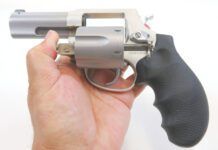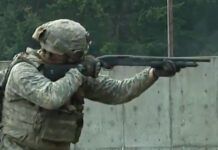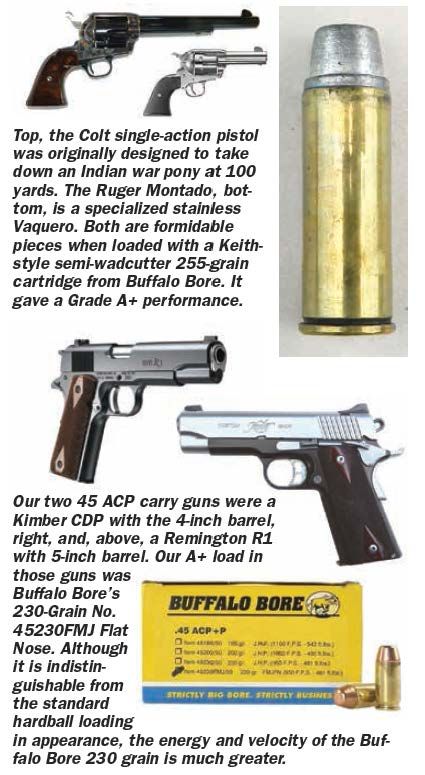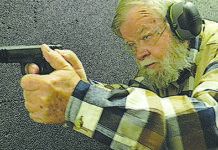Grizzly Bear Shot and Killed By Hikers In Denali National Park and Preserve
(May 31, 2010) — A grizzly bear that emerged from a thicket and charged two backpackers in the backcountry of Denali National Park and Preserve was shot and killed by one of the two who was carrying a .45-caliber semi-automatic pistol, according to park officials.
According to a release from the park, the two backpackers, a man and woman, were hiking in dense brush along the edge of Tattler Creek, which is at the west end of Igloo Canyon roughly 35 miles from the park headquarters.
“The man, who was in the lead, drew a .45 caliber semi-automatic pistol when they heard a noise coming from the brush. When the bear emerged from the thicket and ran toward the other hiker, he fired approximately nine rounds in its general direction. The bear stopped, turned, and walked back into the brush, where it quickly disappeared from view,” said the release. Source: National Parks Traveler.
Alaska Grizzly Bear Kills Calif. Man In First Fatal Bear Attack At Denali National Park
(August 25, 2012) — The hiker was identified as Richard White, 49, of San Diego. Officials learned of the attack after hikers stumbled upon an abandoned backpack along the river about three miles from a rest area on Friday afternoon. The hikers also spotted torn clothing and blood. They immediately hiked back and alerted park staff. Rangers in a helicopter spotted a large male grizzly bear sitting on the hiker’s remains, which they called a “food cache” in the underbrush about 100 to 150 yards from the site of the attack. Source: Associated Press.
While bear attacks seem rare, a bit of research seems to indicate that they are not as distant a problem as one would first think. And the fact is, no handgun round is a good choice for killing a bear bent on defending its home or cubs. A sick or wounded male bear is an even worse threat. But some loads are hopeless, while others have merits. Frankly, feral dogs and human attackers are a greater threat. A bear or one of the big cats is the worst-case scenario. We are certain that the woman recently assaulted on a hiking trail near the Smokies wished she had any gun at all on hand.
As for bears, the largest of North American animals that are likely to attack humans, we need plenty of penetration from our sidearm. And sometimes we are not carrying purpose-designed handguns intended for use against wild animals, but rather common packing pistols. Though custom-chambered breech-blocks or Magnum revolvers are the best choices, some shooters are not willing or able to invest in a bear-defense pistol. Expense and the daunting proposition of learning to control recoil are considerations that become hurdles. So, more common and milder big-bore cartridges are sometimes carried in the wild, including the 45 ACP and the 45 Colt.
This report is reader generated, in the sense that it’s the result of feedback and numerous requests from Gun Tests subscribers concerning the feasibility of defending against bear attacks with either of these calibers. Neither is a Magnum and neither was expected to equal the performance of the 357 Magnum revolver, the 44 Magnum, the Casulls, or the Linebaughs. We’ll just say up front these are better choices for wild-area self-defense handguns.
We learned a lot when testing the 357 Magnum and the many loads available for it. For instance, when deploying the 357 Magnum, we tested a number of fast-opening JHP loads. There was little point in doing the same with the 45 Colt here; we wished to test only the high-penetration loads.
After the 357 Magnum test, a number of readers noted that the hard-cast heavy-weight load from one maker, Buffalo Bore, would have performed better than the same maker’s 158-grain JHP load tested. It is true the heavy cast bullets were the most effective in penetration, while for big cats and feral dogs the heavy JHP load would be a good choice. Had we tested BB’s 180-grain cast load, it would have been a winner in 357 Mag.
Accordingly, in this installment, we eliminated lightweight loads and went for the gold. The criteria we set for animal defense was penetration of no less than 36 inches. This means six 6-inch-diameter 1-gallon milk jugs. As long as the load penetrated these jugs, it would be acceptable. Of course, we still looked for a high level of consistency and accuracy, but at the likely bad-breath range encountered in animal attacks, these factors were not as important as ballistic performance. As a result, we concentrated upon solid non-expanding bullets. This wasn’t a comparison of the 45 Colt and the 45 ACP, but rather the best loads for the respective calibers. Just the same, there is a difference in handguns. In many animal attacks, the bruin or big cat bowls its human prey over. Sticking the revolver in the face, chest, or guts of the animal and pressing the trigger gives you a chance to fire another round. However, because of contact, the self-loader could jam after the first shot. If you are deploying the automatic, hope that you see the animal coming (as in the Denali example above) and have a few moments to aim and put the lead where it will do the most good.
Standard 45 ACP hardball may have a good reputation for penetration against human targets, but when it comes to large animals, the record isn’t very good. We took a hard look at the ammunition scene and came up with a few loadings with any chance of effect against the big bears. A roundnose jacketed bullet just isn’t going to be as effective against a large animal as a big, flat semi-wadcutter bullet. However, we were able to test two heavy loads from Buffalo Bore. As for lightweight bullet loads, in the past there was a special high-speed 185-grain FMJ load available from IMI that one of our raters spoke up with admiration, but we were unable to locate any of these loads. No jacketed hollowpoint could meet our criteria for penetration, and all standard-pressure FMJs would perform about the same as in previous tests and fail here, since they are designed for a different attacker.
Test Handguns
We elected to use four handguns for the primary testing. Two 45 carry guns were a Kimber CDP with the 4-inch barrel and a Remington R1 with 5-inch barrel in 45 ACP. For the 45 Colt, we chose a Ruger Montado (a special model of the Vaquero) with 3.9-inch barrel and a 7.5-inch barrel Colt SAA. These handguns represent, to us, revolvers that might be carried in the wild but were not per se hunting handguns.
The hunting handgun point is important. We consulted Mike Shovel at Cor-Bon concerning his heavy 45 Colt loads and found none are rated for use in the Vaquero and certainly not a Colt Single Action Army. The Cor-Bon hunting loads are intended for the heavy-frame Rugers such as the Redhawk.
The same goes for the heavy Buffalo Bore loads. Sure, they would outclass the loads tested, but they are meant for heavy hunting handguns, not the common packing pistol. This meant we were limited to heavy — but standard pressure — loads for use in the type of revolver that might actually be used for animal defense. The 320-grain loads and the like that have maximized the 45 Colt for hunting simply would not be safe in the Vaquero or the Colt SAA.
The 45 Colt loads gave us the most confidence, but the souped-up 45 ACP loads are impressive as well. There isn’t much to choose from, but the few loads that are available do all that can be done with these cartridges. Shot placement will count for the most, as usual.
If we had a choice, we’d pack stouter guns and loads for bear-country treks. But many of us don’t have such an option, so some of these loads allow reasonable double duty for guns you already own to be used in bear defense.
45 Colt Buffalo Bore 255-Grain SWC 3E/20, $40.34/20
The standard Keith-type semi-wadcutter used in this round has many advantages. The weight of the bullet is carried out of the cartridge case, which allows for more powder capacity and less pressure with a heavy load. The flat nose and the sharp shoulder allow promote excellent cutting ability. There are sorry renditions of the SWC, particularly in the softer factory loads, but Buffalo Bore uses a true Keith SWC. As a bonus, accuracy at long range is often excellent with this design.
This standard-pressure “heavy” load uses a gas-checked soft-cast semi-wadcutter (SWC) bullet that roughly duplicates the old 255-grain SWC load with a stiff charge of Unique powder that produced some 1000 fps in most revolvers. This load is accurate and meets the penetration criteria. The Buffalo Bore SWC load demonstrated a strong recoil push, but that is the price of power. Recoil is the only drawback, but it is not uncomfortable, simply strong.
Gun Tests Grade: A+
45 ACP Buffalo Bore 230-Grain No. 45230FMJ Flat Nose, $56.24/50
This load used a full-metal-jacketed flat-point bullet. Since feeding is always perfect with this design, there is no reason to choose a roundnose bullet. At more than 900 fps, this is a truly heavy load well worth your time and consideration. Recoil, again, was brutal in the CDP.
Gun Tests Grade: A+
45 Colt Buffalo Bore Standard-Pressure 225-Grain Wadcutter No. 3L/20, $40.34/20
This is an interesting personal-defense load — a full wadcutter that cuts a generous .454-inch hole in the target. It is just slightly faster than the 255-grain load. For some reason, this load kicks a bit less than the 255-grain load. It was noticeable. Because many revolvers shoot a bit high, this lighter load was more on target with the fixed-sight revolvers. For the big cats or personal defense, this bullet tracks straight and does not rely upon expansion for effect. Penetration is adequate, but for bears, we would recommend the heavier bullet. Just the same, this is a formidable loading. It gets an A grade rather than an A+ only because we prefer the heavier 255-grain load.
Gun Tests Grade: A
45 ACP Buffalo Bore 230-Grain +P FMJ No. 45230, $56.24/50
This powerful load was not pleasant to fire in the lighter CDP. Still, it would give us an edge over standard hardball in the light and portable CDP. In the R1, the Buffalo Bore load was much more pleasant to shoot, with no more push, subjectively, than most other +P loads. It sailed through the perquisite amount of water, and accuracy was good. Muzzle flash was subdued, which means good powder burn. Velocity was well over 900 fps, about 100 fps faster than most hardball loads.
According to the Buffalo Bore site, “45 ACP +P ammo is externally/dimensionally identical to 45 ACP ammo and can be fired in any 45 ACP firearm that is in normal operating condition. However, the greater pressures and power of the +P ammo will give you greater slide velocity, and if you are going to shoot more than a box or two of +P ammo, you should consider replacing your recoil spring with a Wolff Spring that gives roughly 4 to 6 pounds more spring weight than factory stock springs. A shock buffer might also be a good addition, although not necessary if you use the stronger spring.”
Gun Tests Grade: A
45 Colt Winchester 255-Grain Lead Roundnose X45CP2, $20.22/20
This is a classic 45 Colt lead-bullet load, although perhaps not as strong as it once was. We primarily tested this load to give us a basis for procedure in comparison. This load averaged about 805 fps from the Vaquero. Performance was impressive as a personal defense load, but not as a load for personal defense against bears. It isn’t designed or offered as such.
The fat 45 averaged about 18 to 24 inches in water for penetration. However, the bullet seemed to tumble, sometimes exiting one side or the other of the jugs. It did not track straight after the first 7 or 8 inches. Sometimes, we would fire low and the bullet exited high. All of this means the 255-grain bullet would do a lot of damage in a man-sized target. Such is the reputation of this cartridge with relatively soft bullets. Against large animals it would be less than ideal.
Gun Tests Grade: B
Written and photographed by R.K. Campbell, using evaluations from Gun Tests team testers. GT


















